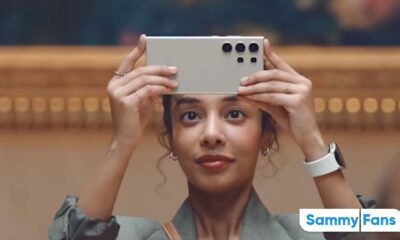Tips
15 smart Samsung One UI 4.1 Gallery app tips
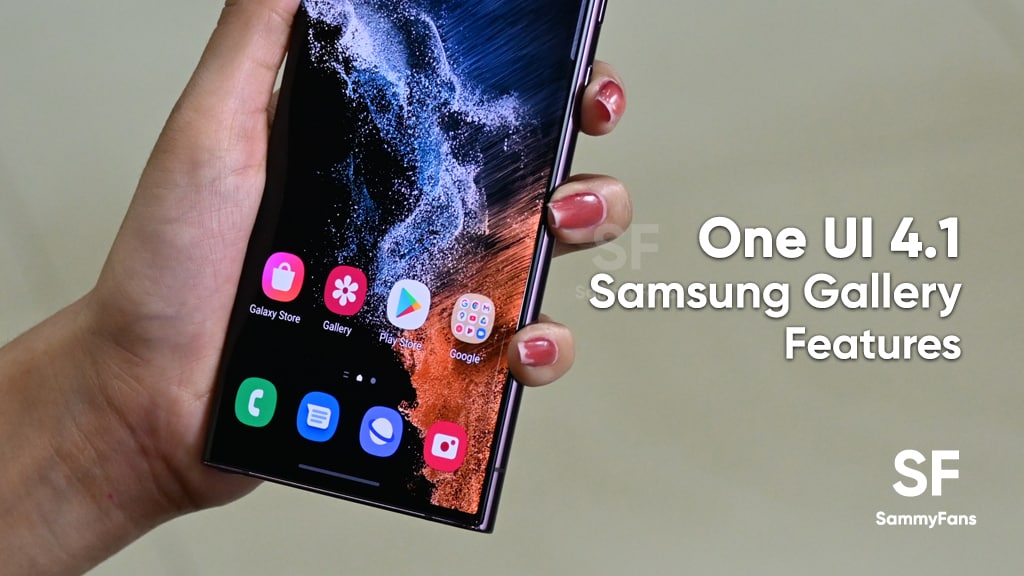
Samsung smartphones come with the company’s in-house Gallery app. Samsung Gallery app stands out with tons of editing tools, organization options, and a neat OneDrive integration. Meanwhile, it has been further improved with the all-new Object eraser and other editing tools in One UI 4.1.
Among various new features, One UI 4.1 Photo Remastering is the most notable change. It lets you improve the quality of dark, out-of-focus, or low-resolution images. It reduces blur, eradicates noise, and also increases the resolution of your images, and more.
Join SammyFans on Telegram
There’s a lot to do with your Galaxy phone’s Gallery app. Here I’m going to give you some smart Samsung One UI 4.1 Gallery tips that will change the way you use your phone’s Gallery.
DOWNLOAD SAMMY FANS APP

Smart Samsung One UI 4.1 Gallery tips
Enable Samsung Gallery Labs:
Gallery Labs is a hidden menu and can be enabled in a similar style ad Developer options. It has some experimental features in Samsung Gallery.
- Open Samsung Gallery.
- Tap the 3-dot menu button in the bottom-right corner.
- Tap Settings.
- Scroll down and head over to About Gallery.
- Repeatedly tap the Gallery version (the numbers, not the word “Gallery”) 7-8 times.
- You should see a toast notification saying that Gallery Labs has been enabled.
- Go back to Gallery settings.
- Scroll to the bottom of the list where you should see the Gallery Labs option.

Move photos to Secure Folder:
Samsung Secure Folder keeps your private photos, videos, files, apps, and data safe and secure. The service also allows you to add a passcode or biometric lock to keep your data safe from any others eyes.
- Select the photos, videos, or albums that you want to move to Secure Folder.
- Tap the More button in the bottom navigation drawer.
- Select the Move to Secure folder option.
If you are using it for the first time, you will have to set up a Secure Folder by granting it the necessary permissions and entering a password/pattern/PIN lock.

Give Object Eraser a shot:
With One UI 4.1 Object Eraser, users can now easily remove not only background disturbances but also shadows in the subject or reflections in the picture.
- Open the photo in the Samsung Gallery app from which you want to remove an object.
- Tap the Pencil icon from the bottom toolbar to enter into editing mode.
- Tap the 3-dot menu button in the bottom right corner.
- Select Object eraser.
- Tap or draw on the object that you want to remove from the photo.
- You can erase shadows and reflections by selecting the appropriate option.
- Tap Erase to see the results.

Add spot color to your photos:
Spot color allows you to turn a photo black and white, with only some specific parts or objects remaining in color. This can be used to make certain subjects pop in a photo.
- Open the photo in the Samsung Gallery app from which you want to re-color an object.
- Tap the Pencil icon from the bottom toolbar to enter into editing mode.
- Tap the 3-dot menu button in the bottom right corner.
- Select Spot color.
- The photo is automatically converted into black and white.
- Tap on an object that you want to be in color.
- The changes will also be applicable for all objects or subjects of the same color in the photo.
- You can use the Remove color or Erase color options to remove them from unwanted objects.
- Tap Done to apply the changes.
- Select Save from the top right corner to save the photo.

View and edit Exif data:
Samsung Gallery makes it easy to view the Exif (Exchangeable image file format) data of the photos and videos you shoot. You can even edit this data if you wish. To view the Exif data like resolution, size, and geotagged location, simply open a photo or video and swipe up.
- Tap the arrow near the EXIF data in the Samsung Gallery app.
- You’ll see a more detailed look at the EXIF data.
- Tap Edit in the top right corner.
- Change the date, time, file name, and the geotagged location of the file.
- Select Save when done.
Hide private albums:
New folders containing photos and videos on your phone appear as a new album in the Gallery app, including folders created by third-party apps. If you want to keep your gallery clean and organized, you can hide unwanted albums and folders.
- Open Samsung Gallery app.
- Tap the 3-dot menu button in the top right corner.
- Tap hide or unhide albums.
- Toggle the albums/folders you want to hide.
- You cannot hide some folders like Camera and Screenshots.

Drag and drop photos content between albums:
If you have more than one folder or album in Samsung Gallery, you can move media files between them with a simple drag and drop gesture.
- Open Samsung Gallery app.
- Select multiple photos and videos and long press on them.
- This will bring up the list of available folders or albums in a sidebar on the left.
- Drag and drop the items to the desired folder.

Sync Samsung Gallery with Microsoft OneDrive:
Samsung offers native OneDrive integration in its Gallery app. If you’re already subscribed to Microsoft 365, you can take advantage of 1TB of OneDrive space and back up all your photos and videos.
- Open Samsung Gallery app.
- Tap the 3-dot hamburger menu button in the bottom right corner.
- Tap Settings.
- Select Sync with OneDrive.
- Agree to the terms and conditions and then tap Connect.
- Proceed to connect your Samsung and Microsoft accounts.
- You’ll need to sign in to your Samsung account if you have not already done so.
- Then log in with your Microsoft account.
- Now, all photos and videos in your Gallery are automatically backed up to OneDrive.

Recover deleted photos and videos:
Accidentally deleted an important picture while freeing up storage space on your phone by deleting useless photos and videos? Don’t worry, Samsung Gallery has the ability to recover deleted photos and videos for up to 30 days.
- Open Gallery of your phone.
- Tap Menu (three dots).
- Select Trash.
- Tap Edit.
- Select photos or videos you want to restore.
- Finally, tap Restore.

Add portrait effect to photos:
You can add a portrait effect to photos after taking a shot. This feature works best with selfies and your mileage may vary with shots taken with the primary rear camera.
- Open the photo in the Samsung Gallery app.
- Tap the 3-dot menu button in the bottom right corner.
- Select the Add portrait effect option.
- Samsung Gallery will then analyze the photo and automatically add the blur effect.
- A slider will be shown which you can use to adjust the blur intensity.
- Tap Apply when done to save the changes.
- Alternatively, you can keep the original photo unmodified by using the Save as copy option from the 3-dot menu in the top right.
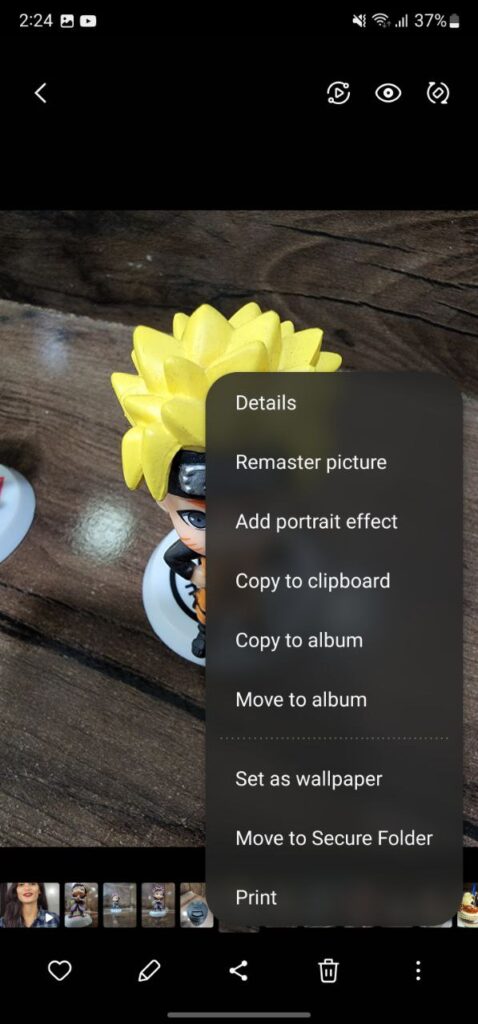
Remaster your photos:
Samsung Gallery app has remaster option to tweak your photos.
- Open the photo in the Samsung Gallery app.
- Tap the 3-dot menu button in the bottom right corner.
- Select the Remaster picture option.
- The photo will be analyzed and a before/after will be shown so that you can easily make out the differences.
- If you like the changes, tap Save.
- You can save the edited photo as a separate copy by tapping More and selecting the Save as copy option.

Use a photo in Samsung Gallery as your custom wallpaper:
You can set any photo that you like as your phone’s home screen, lock screen, or Always-On Display wallpaper directly using Samsung Gallery.
- Open the Samsung Gallery app followed by the photo you want to set as wallpaper.
- Tap the 3-dot menu button in the bottom right corner.
- Select Set as wallpaper.
- Now select where you want to set the wallpaper: Home screen, Lock screen, Always On Display, Call background or Watch face.
- Depending on your option, a preview will be shown where you can adjust the crop.
- Confirm your action when done.

Bixby Vision:
Samsung is a useful Google Lens-like feature that’s baked into Samsung Gallery. You can use Bixby Vision to identify objects in your photos or even copy text from images.
- Open the Samsung Gallery app followed by a photo of your choice.
- Tap the Bixby Vision icon located in the middle of the toolbar on the top.
- Bixby will then scan the photo to find text or subjects.
- If text is detected in the photo, you can copy, translate or search for it on the web.
- You can view similar images on Pinterest by tapping the Find icon at the bottom.

Let Samsung Gallery analyze your photos and make suggestions:
Samsung Gallery can analyze your photos and recommend changes like adding portrait effects, remastering them to enhance their look, and deleting duplicate photos to free up space.
- Open the Samsung Gallery app.
- Tap the hamburger menu button located in the bottom right corner.
- Select Suggestions.
- Recommendations for various photos on your phone will be shown here.
- You can tap on a suggestion to read more about the recommended changes.
- A before/after comparison will also be shown for comparison purposes.
- Proceed to Save the photo if you like the changes.
- You can also directly share the edited photo or remove the changes.

View a photo landscape mode without rotating your Samsung Galaxy phone:
You don’t need to enable auto-rotate to view a photo in landscape mode in the Samsung Gallery app. Simply tap the Rotate button in the Gallery’s image viewer to switch to landscape view or vice versa. It is a useful feature to have since it does not affect the system’s auto-rotate setting.
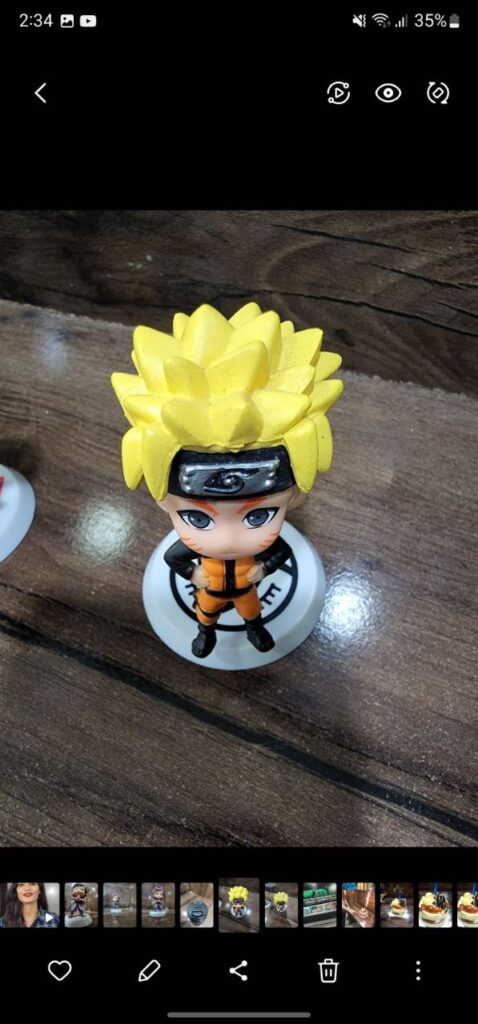
Get notified –
Aside from SammyFans’ official Twitter and Facebook page, you can also join our Telegram channel, follow us on Instagram and subscribe to our YouTube channel to get notified of every latest development in Samsung and the One UI ecosystem. Also, you can follow us on Google News for regular updates.
One UI
One UI 6.1.1’s Motion Clipper feature coming to these Samsung devices

One UI 6.1.1 introduced several new features and enhancements, one of which is the Motion Clipper feature of Editor. This feature lets you enhance your photos and create unique GIFs and stickers. This tool is perfect and useful for those who want to add a bit of fun and creativity to their photos and share them.
Motion Clipper is a minor yet powerful feature of One UI 6.1.1 that allows you to turn a part of your Motion Photos into animated GIFs or motion stickers. Users can easily use this feature when they have a motion photo in the Gallery app.
You have to open the motion photo in the Gallery app and long-press on a person or object you want to select. By doing so, you create a GIF or sticker from it. You can now use these custom GIFs and stickers on messenger apps or social media platforms that support Sticker Center.

Image Credit: Samsung
Currently, Motion Clipper is available on select Samsung models including the Galaxy Z Fold 6 and Flip 6. Additionally, several other flagships will get this feature with next major update.
These Galaxy devices will soon get the Motion Clipper feature of One UI 6.1.1.
Galaxy Z series
- Galaxy Z Fold 5
- Galaxy Z Flip 5
- Galaxy Z Fold 4
- Galaxy Z Flip 4
Galaxy S series
- Galaxy S22
- Galaxy S22 Plus
- Galaxy S22 Ultra
- Galaxy S23
- Galaxy S23 Plus
- Galaxy S23 Ultra
- Galaxy S24
- Galaxy S24 Plus
- Galaxy S24 Ultra
Galaxy Tab Series
- Galaxy Tab S8
- Galaxy Tab S8 Plus
- Galaxy Tab S8 Ultra
- Galaxy Tab S9
- Galaxy Tab S9 Plus
- Galaxy Tab S9 Ultra
One UI 6.1.1 will bring Sketch to Image feature to older Samsung devices
Tips
Here’s how to use gesture features of Samsung Galaxy Ring

On July 10, Samsung launched the smallest and most compact product within the Galaxy lineup, the Galaxy Ring. It offers several innovative health management functions along with an exciting way to control your phone using simple gestures. You can easily activate gesture features on your Galaxy Ring.
Samsung Galaxy Ring’s gesture feature lets you turn on an alarm or take a photo or video while the camera app is running by double-clicking your finger and thumb while wearing the ring.
How to activate gestures on Galaxy Ring :
To use the Galaxy Ring’s gesture controls, follow these steps:
- Open the Galaxy Wearable app on the smartphone connected to the Galaxy Ring.
- Navigate to the “Gestures” section within the Galaxy Ring’ Settings.
- Choose which functions you want to control with gestures. Options include dismissing an alarm or taking a photo or video.

After you have chosen your desired functions, you can start using them by performing a simple gesture. To dismiss an alarm or capture a photo or video, double-tap with your finger and thumb while wearing the Galaxy Ring. This gesture will start the selected function without needing to touch your phone.
If you have a Galaxy Z Fold 6 or Z Flip 6 model, you can start using these features. This feature will be extended to other Galaxy devices through future software updates.
Galaxy Ring
Samsung Galaxy Ring features a sleek design with dimensions of 7.0 mm x 2.6 mm, 24-hour-a-day health monitoring, long-lasting battery from 18mAh (Size 5) to 23.5mAh (Size 13), Galaxy AI features, and more.
Moreover, the Galaxy Ring provides comprehensive health insights and analysis via the Samsung Health app without any additional fees. It gives detailed metrics on sleep patterns, including movement, sleep latency, heart rate, and breathing rate during sleep. It also introduces Energy score and Wellness tips for daily health insights.
Samsung finally releases Galaxy Ring: Here’s all you need to know
Samsung
Samsung One UI 6.1.1 Galaxy AI’s Portrait Studio

Samsung launched the Galaxy Z Flip 6 and Galaxy Z Fold 6 with One UI 6.1.1 software, introducing an impressive feature called Portrait Studio. This feature uses generative AI to transform normal photos into artistic portraits with just a few taps.
Portrait Studio of One UI 6.1.1 is accessible through Gallery and Contacts apps. It offers four different styles of portraits- Comic, 3D Character, Watercolor, and Sketch. Whether you prefer a comic-inspired look or a watercolor effect, there’s a style for every taste.
The process of using the Portrait Studio is very simple. First, select a portrait photo from your gallery, pick the desired style, and let the AI work its magic. Even if there are multiple people in the photo, you can select which individual you want the portrait created for.

The AI processing takes around 15 seconds to generate the portrait, and if you’re not completely satisfied with the result, you can easily create another version with the ‘Create Again’ button. Final Portraits can be saved through the photo editor or you can set directly it as a profile image for contacts.

The quality of the generated portrait improves with higher-resolution photos where the subject is visible and facing forward. Also, all portraits created using Portrait Studio contain a watermark in the bottom left corner to indicate their AI generation.
The good news is that Samsung plans to expand the availability of Portrait Studio beyond the Galaxy Z Flip 6 and Z Fold 6. Users of Galaxy Z Fold 5, Galaxy Z Flip 5, Galaxy Z Fold 4, Galaxy Z Flip 4, Galaxy S24, Galaxy S23 FE, Galaxy S23, Galaxy S22, Galaxy Tab S8, and Galaxy Tab S9 devices will soon also enjoy this amazing feature.
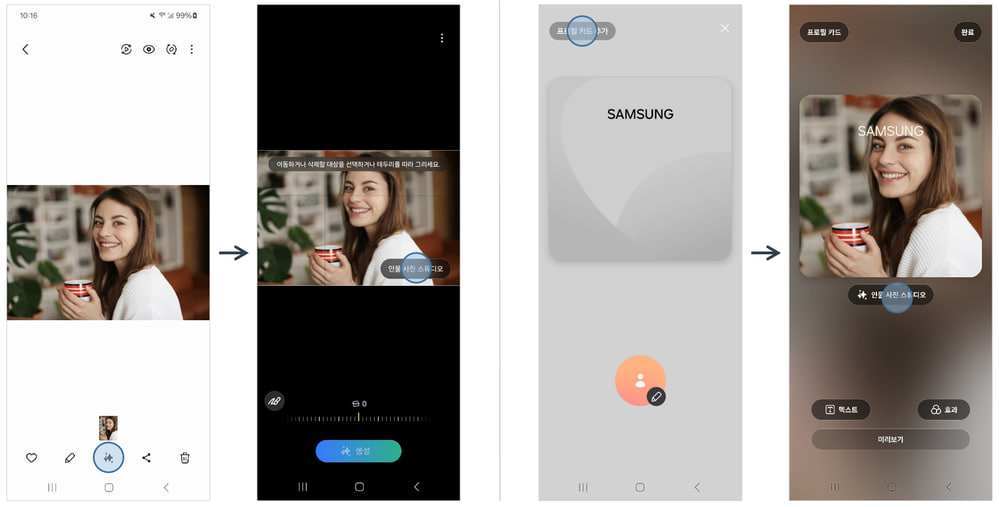
As the rollout progresses, more Samsung users can enjoy the amazing styles of AI-enhanced portraits on their smartphones. Stay tuned for more information.
One UI 6.1.1 update will bring Auto Zoom feature to Galaxy Z Flip 5



